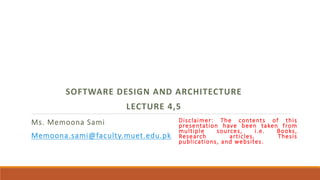This document provides an overview of software architectures and architectural structures. It discusses different types of architectural structures, including module structures, component-and-connector structures, and allocation structures. Module structures focus on modules and their relationships, component-and-connector structures examine runtime components and connectors, and allocation structures show how software elements map to environments. The document then examines specific architectural structures like modules, layers, classes, processes, repositories, and deployment. It emphasizes that an architect should focus on a few key structures like logical, process, development, and physical views to validate that the architecture meets requirements.



















![Software Architectures
WHICH STRUCTURES TO CHOOSE?
Which ones should an architect work on? Which ones should the architect document? Surely not all of
them.
There is no shortage of advice. In 1995, Philippe Kruchten [Kruchten 95] published a very influential
paper in which he described the concept of architecture comprising separate structures and advised
concentrating on four to validate that the structures were not in conflict with each other and together
did in fact describe a system meeting its requirements. This is known as 4+1 approach (4 view points + 1
redundant view point).](https://image.slidesharecdn.com/sda-2-211030081226/85/Sda-2-20-320.jpg)








